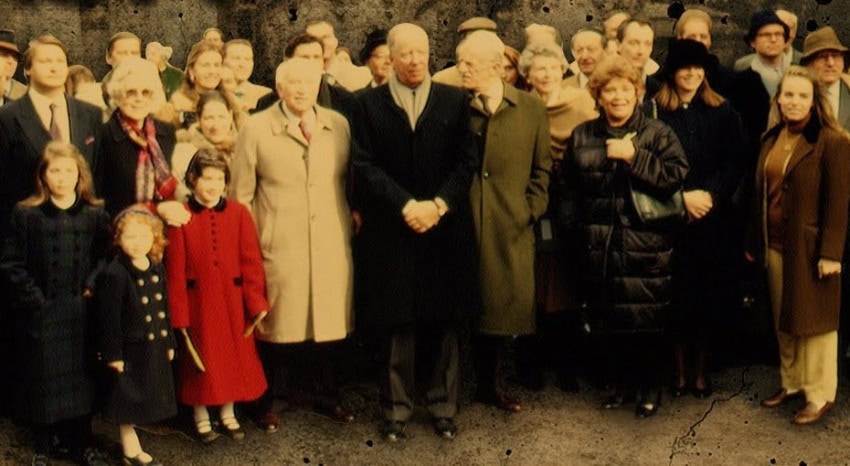Since the beginning of the nineteenth century, the Rothschild dynasty has been considered as the richest and most powerful dynasty in the world. The Rothschilds are said to be the leaders of a secretive clique of banking families who instigate wars and revolutions, and who, in general, keep mankind in a state of perpetual conflict, bloodshed and stress. In the words of Col. L. Fletcher Prouty, an important U.S. intelligence officer, this Cabal remains “superior” because it has learned the “value of anonymity”. The goal of these Rothschild led families is a One World slave state with a much reduced global population under their absolute control.
By funding both sides in instigated wars, the Rothschilds ensure that they will reap enormous profits and gain greater influence. In this technique the winning side always squeezes its own debts, as well as those of the losing side, out of the loser. Instead of providing loans to individuals the Rothschild developed the art of providing loans to governments. This brought them huge profits. In the words of Frederic Morton: “Someone once said that the wealth of Rothschilds consists of the bankruptcy of nations.” E.C. Knuth writes: “The fact that the House of Rothschild made its money in the great crashes of history, and the great wars of history, the very period when others lost their money, is beyond question.”
The Rothschild dynasty was founded by Mayer Amschel Bauer (later Rothschild). His five sons carried his work forward. Mayer Amschel Bauer (1743-1812) was born and lived in Judenstrasse (Jew Street), a ghetto in the city of Frankfurt (some sources mention 1744 as his year of birth). His father Moses Amschel Bauer was a moneylender and a proprietor of a counting house. A counting house is an office where records of businesses are kept.
As a child Mayer Amschel was sent for training as a Rabbi at a Yeshiva (a Jewish madrasah) near Nurnberg. However, very early on, he realized that he had greater interest in making money, which he, even as a very young rabbinical trainee, was making by dealing in coins. He therefore gave up his rabbinical studies and returned to Frankfurt. He suddenly lost his parents in 1755. It is unclear as to whether he left his rabbinical studies after or before the death of his parents. According to Fredric Morton he had to give up his studies because of the death of his parents.
In his locality in Frankfurt he gained a reputation as a brilliant lad, and, as a result of the loss of his parents, was given an opportunity to work with the Oppenheim Bank in Hanover. The exact years of his employment at Oppenheim are not mentioned by historians, but it is said that he worked there in the 1760s. He had very good working habits and at a young age was made a co-manager at the bank. At the Oppenheim bank he made the acquaintance of Lt. Gen. Baron von Estorff, who was advisor to Frederick II, the Landgrave of Hesse (in Germany in those days Landgrave was a man who had jurisdiction of a territory). Frederick II was said to be the richest man in Europe at the time.
Mayer Amschel may have done something favorable for von Estorff, but historians are not sure as to what exactly it was. This acquaintance was to open doors to immense wealth and power for Amschel later on. In the words of Eustace Mullins: “Baron von Estorff advised the Landgrave that Mayer Amschel showed an uncanny ability to increase money through his investments. The Landgrave immediately sent for him.” How could the Baron know of Amschel’s ability in making sound investments? It is possible that Amschel might have brought profits for von Estorff through his abilities. And it was through his association with the Landgrave that Mayer Amschel must have made money for himself as well. But this exposure to the Landgrave happened after he had returned to Frankfurt.
Having gained experience and saved money, Mayer Amschel decided to launch his own business, resigning from the bank. The year he did so is also not mentioned by historians. However, Frederic Morton writes in his The Rothschilds that Mayer Amschel returned to Frankfurt in 1764. Assuming that he began working with Oppenheim in 1755 or 1756, he, it appears, stayed with them for eight or nine years. His two brothers were already there, so he most likely, took up his father’s business in coins and moneylending with them.
Frederic Morton states that Mayer Amschel began preparing very beautifully written, and later printed, catalogs of his coins and wrote letters to important people who would be interested in them. He ventured to the castles and manors around Frankfurt. He also managed to connect again with Gen. Estorff, who remembered him. The courtier friends of Gen. Estorff showed a “nice interest in his quaint coins and heirlooms.” One day he had the good fortune of being ushered into the presence of the Landgrave, who, having won at chess, was in a good mood. In the words of Morton: “Mayer sold him a handful of his rarest medals and coins. It was the first transaction of a Rothschild with a chief of state.”
On September 1, 1769, passersby noticed that a man was fixing a board on his shop which said: “M.A. Rothschild by Appointment Court Factor to His Serene Highness, Prince William of Hannau.” The board also bore the arms of Hesse-Hannau. Using the red hexagram on his shop he had adopted the title Rothschild, which, in German, means red shield. This board created a sense of excitement in the neighborhood. He had developed enough interaction with the Prince to be able to put up such a board. It had taken him five years of patient labor to get to this stage.
It was after his first success with the Landgrave that Mayer instituted in his shop a Wechselstube, i.e. a “rudimentary bank where the multifarious currency of the Germanics could be exchanged. The fairs held in Frankfurt brought all sorts of ducats, florins, carolins and what-nots into town. From this diversity Mayer now steadily profited.” He had taken a small step towards becoming a banker.
Mayer Amschel married Gutle Schnapper (1753-1849) in August 1770. The couple had ten children, five sons and five daughters. Since the daughters of the Rothschilds are never associated with their business, we will mention only the five sons, who, consolidated the Rothschild dynasty founded by their father. The five sons were (all carried the last name Rothschild): Amschel “Anselm” Mayer (1773-1855), Saloman Mayer (1774-1855), Nathan Mayer (1777-1836), Kalman “Karl” Mayer (1788-1855) and Jacob “James” Mayer (1792-1868).
Financial analyst Andrew Carrington Hitchcock, a former academic and police officer, writes in his book The Synagogue of Satan: “1770: Mayer Amschel Rothschild draws up plans for the creation of the ‘Illuminati’ and entrusts Ashkenazi Jew, Adam Weishaupt, a Crypto-Jew . . . who is outwardly a Roman Catholic, with its organization and development. The ‘Illuminati’ is to be based on the teachings of the Talmud…” Hitchcock does not specify how the two met or came to know each other.
To conceive of a practical plan for world control at age 26 or 27, Mayer Amschel Rothschild had to be a truly exceptional man, as history has later testified. There is no suggestion of anyone who mentored him. Perhaps the Talmud was the source of his thinking. Perhaps interacting with the richest man of Europe, whom he advised, gave him the idea that he could do better than those who were fabulously rich and powerful.
At some point Mayer Amschel seems to have become a somewhat important banker. Niall Ferguson, who had access to the Rothschild family archives, makes a very important observation in this context. He writes: “Another exception [to governments that ran deficits] was the German state of Hesse-Kassel, which was effectively run by its ruler at a profit by hiring out of his subjects as mercenaries to other states. Involvement in the management of this huge portfolio was one of the first steps of Mayer Amschel Rothschild took in order to become a banker rather than a mere coin dealer (his original business).”
Mayer Amschel Rothschild’s emphasis on secrecy was extremely crucial to the success of his scheme. Secret networks became vehicles of accurate espionage or intelligence, as well as of subversion whose real perpetrators would remain undetected. Wieshaupt (1748- 1830) too was an exceptional man who, in 1868, at age 20, completed his doctorate of law at Ingolstadt University. After “converting” to Protestantism, he became a professor of law at the same university at a very young age, and sometime later became Dean Faculty of Law. He had been orphaned at age five, and had been sent to a Jesuit school to become a Jesuit priest. His father was also a professor of law. His father was Jewish but had “converted” to get his position.
English born Canadian naval officer William Guy Carr (1895-1959) investigated the “World Revolutionary Movement” for four-and-a-half decades. In his famed book, Pawns in the Game, published in 1958, he states: “In 1773 Mayer Rothschild was only thirty years of age, he invited twelve other wealthy and influential men to meet him in Frankfurt. His purpose was to convince them that if they agreed to pool their resources, they could then finance and control the World Revolutionary Movement and use it as their manual to win ultimate control of the wealth, natural resources and man-power of the entire world.” Carr does not specify any source for this information.
According to Carr, it was at the said meeting that Mayer Rothschild read out, carefully, from a manuscript, the entire plan and tactics for taking over the whole world. The plan is quoted at length in Carr’s book but it is unclear, as to what the source of his information was. There is a great overlap between the Rothschild plan, between the Illuminati plans that were recovered by Bavarian police when an Illuminati courier was hit by lighting in1784, and between the famed Protocols of the Learned Elders of Zion. Carr notes the similarity but expresses the opinion that instead of a plot of the Elders of Zion, “[I]t would appear it was a plot presented to moneylenders, Goldsmiths, Industrialists, Economists and others by Amschel Rothschild …”
George Armstrong notes in his The Rothschild Money Trust: “The protocols and the communist code, which are identical in purpose and intent, represent their plan for the conquest of the world. Both of these codes were published subsequent to Mayer Amschel’s death, but some of the protocols appear to have been in existence prior thereto. They, however, represent his principles as shown by all that we know of him.” Please note that the communist code is nothing but Illuminati code in a new garb. Weishaupt launched his Illuminati movement on May 1, 1776. He decided to capture Freemasonry as their lodges would provide cover and sanctuary to the Illuminati. He became a Freemason in 1776. All Rothschilds to date are Freemasons.
King George III of England was trying to put down the revolt in the American colonies at that time. Mayer Amschel, it is believed, brokered a deal in which the Landgrave of Hesse was to supply 16,800 mercenaries to suppress the revolt. Or at least he worked out the financial aspects of the deal and related investments. This was a very profitable arrangement for the Landgrave and hence for Mayer Amschel, who would get commissions on any such deals and investments. It also familiarized Mayer Amschel with the politics of America and must have provided him with influential contacts in England as well as in America.
https://en.dailypakistan.com.pk/25-Jun-2023/the-greatest-conspiracy-against-the-people-of-america
Former MI6 agent, John Coleman notes in his The Rothschild Dynasty: “Instead of the lump sum payments being sent to Kassel, the home of the Prince, the money was retained in England, where it was invested. The interest thereon (negotiated by Amschel) was paid to the Landgrave in drafts. That portion of money actually transferred to Kassel was then used to provide high interest loans to other needy princes. This resulted in a tremendous movement of funds in and out of Kassel with substantial income to the Landgrave…” In 1785 Mayer Amschel moved into a five-storey house, indicating his improved financial status. The house was shared with the Schiff family. Schiffs are also the world’s foremost bankers working under the wing of the Rothschilds. This relationship began from day one.
John Coleman mentions that in 1782 Mayer Amschel Rothschild called for Weishaupt, who was living in difficult circumstances. After this meeting “Weishaupot appeared in Paris with millions of francs at his disposal. He ‘imported’ at least 30,000 criminals of the worst type and set them up in dens in Paris.” In 1784 plans for a bloody French Revolution are issued by Weishaupt. These plans are discovered by divine luck when the courier carrying the documents to the Grand Master of the Grand Orient Lodge in Paris, was struck by lightning. After studying these plans, the Bavarian authorities outlawed the Illuminati in 1785.
The warnings of the Bavarian government were conveyed to the monarchies of Europe to whom a copy of the plan was sent. This warning was ignored with catastrophic consequences for the French monarchy. The French “Revolution” broke out in 1789 and the bloodletting continued till 1793. The Illuminati by then had also penetrated America where their existence and intrigues were exposed by Jedidiah Morse, a New England clergyman whose sermons were published in 1797-98.
On account of the Illuminati and Freemasonic connections developed by Mayer Amschel, he made a successful bid to open and acquire America’s first central bank, the First Bank of the United States, in the year 1791. This bank was a private bank and had a charter for twenty years. Alexander Hamilton, the then Treasury Secretary had proposed setting up such a bank with fifteen million dollars, of which two-thirds (i.e. ten million), was to come from European sources. The European sources were none other than Mayer Amschel Rothschild himself and/or his front-men.
The First Bank of America was set up despite the opposition of men like Thomas Jefferson. That Mayer Amschel Rothschild could do so indicates that not only had he gained enormous wealth and influence by then, he had every intention of controlling and owning the United States of America. His secret society network, particularly the Freemasonic cum Illuminati brotherhood was, most likely, involved in this success. In 1790 Mayer Amschel had said: “Let me issue and control a nation’s money and I care not who writes his laws.” Setting up the First Bank of the United States quietly put Mayer Amschel Rothschild in a different league.
In 1798 Mayer Amschel sent his son Nathan Mayer Rothschild to Britain. He was only 21 years of age at the time, but had great aptitude for business and banking. Nathan started off as a cloth merchant in Manchester. This move was to have immense repercussions, which probably were not foreseen at the time. Eventually Nathan was to move to London to deal in stocks at the Stock Exchange, where because of his tremendous skills, he became known as the man who knew how to manipulate the Stock Exchange to his advantage.
Niall Ferguson writes in his The House of Rothschilds that the period 1793-1815 was a period of “recurrent warfare, the fiscal effects of which were profound.” War expenditures led to inflation, the uncertain conditions in France led to the collapse of the franc. Further, “Disruptions of war . . . created opportunities for making large profits on highly risky transactions such as smuggling of textiles and bullion and managing the investments of exiled leaders.” The Rothschilds engaged in all these activities. Ferguson also noted that “the transfer of large subsidies from Britain to her continental allies necessitated innovation is cross-border payments systems which had never before had to cope with such large sums.”
These circumstances provided the Rothschilds with the opportunity to take “the decisive leap from running two modest firms – a small merchant bank in Frankfurt and a cloth-exporters in Manchester – to running a multinational financial partnership.” That is why in 1815 Nathan Rothschild made the famous statement: “I care not what puppet is placed on the throne of England to rule the Empire on which the sun never sets. The man who controls Britain’s money supply controls the British Empire, and I control the British money supply.”
In the year 1800 Napoleon set up the Bank of France. In the words of South African banker Stephen Mitford Goodson: “He [Napoleon] was thus his own banker, who controlled both the creation and distribution of money and credit, to the chagrin of international bankers, particularly the Rothschilds, who were virtually excluded from operating in continental markets. Napoleon made the franc the most stable currency in Europe. After France had abandoned the loan markets of the City of London, a fog of depression settled on the bankers and usurers.” That is why Napoleon had to continually face war against one coalition of powers or the other, with England as part of each coalition.
Although Napoleon had damaged the international bankers, he, in an unanticipated way, brought a windfall for Mayer Amschel Rothschild. The Landgrave had supplied mercenaries to the Germans and the English against Napoleon. John Reeves writes in his The Rothschilds: The Financial Rulers of Nations: “In 1806 the Emperor [Napoleon] sent a portion of his army to chastise Frankfort and Hesse-Kassel for the support they had given to the cause of the Allies. The truth was that the Landgrave, having a keen eye for business, had found that he could largely augment his already handsome fortune by placing his troops at the disposal of German and English governments, receiving in return large subsidies.”
Upon hearing this Prince Wilhelm of Hesse-Kassel fled to Denmark, leaving behind money, then valued at $3,000,000, with Mayer Amschel Rothschild for safe keeping. That money was in specie (large silver coins called thalers), and being heavy, could not be transported. According to Reeves, Mayer Amschel is said to have told the Prince that lawless ruffians will follow in the wake of the French army and that the army would be there in a week. The Landgrave told him that he knew of his integrity, and would still entrust the money to his care, and will not ask for a receipt. Soon after the French arrived and sacked Rothschild’s premises of everything valuable. He let them do it calmly because he is said to have hidden the money of the Landgrave in wine caskets in his cellar. By allowing the French to steal his valuable property he did not invite a thorough search of his premises and was able to save the money that the Landgrave had entrusted him with.
What happened to this money? The Jewish Encyclopedia of 1909, Vol X, is quoted on this by many authors. “According to this legend the money was hidden away in wine casks and escaping the search of Napoleon’s soldiers when they entered Frankfort, was restored intact in the same casks in 1814 when the elector returned to the electorate. The facts are somewhat less romantic and more business-like.” Armstrong comments: “Mayer Amschel Rothschild embezzled the money. This money was tainted from its very origin. The money was paid by the British government to the Landgrave for the services of the soldiers, used to suppress the American revolution, and the soldiers were morally entitled to it. It was first embezzled by William of Hesse and then by Mayer Amschel. This twice-stolen money is the foundation of the Rothschild fortune.”
It seems highly likely that, instead of hiding it, he probably sent it straightaway with his son Nathan to Britain. That the money went to Britain is indirectly confirmed by the Jewish Encyclopedia. George Armstrong quotes from the 1909 Jewish Encyclopedia, Vol X: “Nathan . . . invested it in 800,000 pounds of gold from the East India Company, knowing it would be needed for Wellington’s peninsula campaign. He made no less than four profits: (1) on the sale of Wellington’s paper (which he bought at 50c on the dollar and collected at par); (2) on the sale of gold to Wellington; (3) on its repurchase; and (4) on forwarding it to Portugal. This was the beginning of the great fortune.”
Mayer Amschel died in the year 1812. In 1811 he had sent his son James to Paris. At the time of his death only two sons were settled abroad. Before he died he laid down certain rules, meant to always be followed by his progeny. Had not one of his grandsons, Anselm, alluded to a section of his will, no one would ever have known that he had left a detailed written will with strict orders. Anselm stated that clause 15 of his grandfather’s will exhorted that “may they [his children] and their descendants remain constantly true to the ancestral Jewish faith.”
The same clause also had the following orders: “I forbid them most explicitly, in any circumstances whatever, to have any public inventory made by courts, or otherwise, of my estate … Also I forbid any legal action, and any publication of the value of the inheritance … Anyone who disregards these provisions and takes any kind of action which conflicts with them shall immediately be regarded as having disputed the will, and shall suffer the penalties for so doing.” Even in his death Mayer Amschel Rothschild stuck to the principle of secrecy and to date no one can know with certainty the real wealth of the Rothschilds.
Mayer Amschel Rothschild had, in addition to secrecy and adherence to Jewish faith, laid down the rule that the eldest son of the eldest son would be the head of the family unless the majority of the family members decided otherwise. In over two centuries since his death there have been two occasions on which the family decided to appoint a younger son as the head. Firstly, upon his death in 1812, his third son Nathan was appointed head on account of his brilliance in the field of banking and business. And then, later on, the fifth son James was made head of the family. At the time of his death his firm M.A. Rothschild & Sons was a family partnership. He directed that it will forever remain so. He also advised marriages among cousins to keep the wealth in the family. Thus the unity of the family was of immense importance for him.
Upon the death of his father, his third son Nathan Mayer Rothschild was made the head of the family on account of his great abilities. The eldest son Amschel Mayer (sometimes called Amschel II) took over the father’s office in Frankfurt. It was decided to send brother number 2 Saloman to Vienna in 1816 and the youngest brother Karl to Naples in 1821. Thus, by 1821, the Rothschild sons had offices in five countries viz. today’s Germany, England, France, Austria and Italy. In 1822 all five brothers were made Barons by the emperor of Austria.
An extremely important story regarding the money made by Nathan Rothschild in the wake of Napoleon’s defeat at Waterloo has been narrated by various authors. The 1913 book The Romance of the Rothschilds by Ignatius Balla is important in this regard because Baron “Natty” Rothschild went to court in New York in 1914 to have the book suppressed on the grounds that the story was false. His case was thrown out by the court, which ruled that the story was true. This was reported by the New York Times on April 1, 1915.
According to Balla, Nathan Rothschild witnessed the last stages of the battle between Wellington’s forces and Napoleon’s army from a high ground at Waterloo. When he realized that Wellington was going to win he rushed and crossed the rough channel by paying 2,000 francs to an intrepid sailor who brought him to Dover, England in stormy weather. According to Balla: “The next morning he was in the Exchange, leaning against a column. His face was extraordinarily pale; he was completely exhausted, and stood with weary eyes and failing knees. He looked like a man who had aged ten years in a night.”
To deceive the market Nathan began dumping his stocks at cheap prices (to his own agents unknown to others). The market panicked thinking that Wellington had lost, because the Rothschilds were known to be better informed than anybody. Nathan’s agents bought everyone else’s stock at cheap prices. The next morning when the news of Napoleon’s defeat arrived the stocks rose and thus, in one day, Nathan Rothschild made a fabulous profit, establishing him as the dominant financial force in England. The Rothschilds have never looked back after this. On 3 May 2015, the Independent published a story with a lengthy headline: “The Rothschild Libel: Why it has taken 200 years for an anti-Semitic slur that emerged from the Battle of Waterloo to be dismissed?” The title reveals it all – it is just a weak attempt to clarify the Rothschild deception, after 200 years! It was in the wake of Waterloo that Nathan had said: “Buy when there is blood on the streets, even if it is your own.”
Niall Ferguson points out: “Three things would give an investor an edge over his rivals: closeness to the center of political life, the source of news; the speed with which he could receive news of events in states far and near; and the ability to manipulate the transmission of that news to other investors. This explains why the Rothschilds spent so much time, energy and money maintaining the best possible relations with the leading political figures of the day. It also explains why they carefully developed a network of salaried agents in other key financial markets, whose job it was not only to trade on their behalf but also to keep them supplied with the latest financial and political views . . . From early stage they relied on their own system of couriers and relished their ability to obtain political news ahead of the European diplomatic services.” They even used trained and fast pigeons for the purpose.
According to John Reeves, Nathan claimed that he had, in five years, multiplied his capital 2,500 times! In the year 1819 Nathan Rothschild provided the English government with a loan of pounds 120 million. From 1818-1832 he issued loans to the Russian, Prussian, Neopolitan, Austrian, Belgian and Brazilian governments. That he was giving loans to so many governments, shows his immense capital as well as his immense influence.
John Reeves quotes the author of the book Stock Exchange: “One cause of his [Nathan’s] success was the secrecy with which he shrouded all his transactions, and the tortuous policy with which he misled those who watched him the keenest.” He would mislead the market through his agents: “To tell who was and who was not his agent was well-nigh impossible for he is known have made his enemies his tools to serve his purposes.” When he was informed one day that a broker was openly saying “how he detested Rothschild and the whole Jewish race”, he calmly remarked “Thank you; I am much obliged. That man will be useful.”
Gutle Schnaper, the mother, lived to the age of 96 and never left the house in Judenstrasse despite entreaties by the sons. She lived a simple life and felt that if she left the house that had brought everything for the Rothschilds, they might lose their fortunes. According to Carrington, before she died she said nonchalantly: “If my sons did not want wars, there would be none.”














